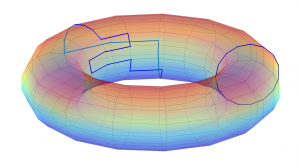My research interests lie primarily in applied algebraic topology and mathematical physics. I try to answer questions in topology and physics by using tools from the other.
I am interested in using ideas from geometry and differential topology to study multiparameter persistence. One of the
first examples of persistence arose from studying the sub-level sets of Morse functions. Together with Peter Bubenik,
we propose looking at generic families of Morse functions to study multiparameter persistent homology. Each of these
families has an associated Cerf diagram, which we believe provides the decomposition of persistence modules
analogous to the barcode decomposition.
My interests have also led me to work on problems in applied topology. Using the tools of topological data analysis to
study fMRI data, we focus on various regions of the brain believed to responsible for certain task and functions. The ultimate
goal is to use TDA to understand complicated networks in these areas,
and to distinguish structure versus function using fMRI. Persistent homology provides a unique framework to
understand this relationship in a novel and efficient way.
My thesis and current research is based on a generalization of electrical current to higher dimensions. Specifically, I’m interested in quantization results for the  `current’generated by sub-objects under some random motion. This breaks into two cases: discrete (CW complexes with Markov processes) or continuous (smooth manifolds with stochastic vector fields), and the tools involved vary for each. One such tool in the discrete case are `higher spanning trees’, and we’ve enumerated them using Reidemeister torsion, an invariant in Algebraic K-theory. We’re still investigating the smooth case, using tools from functional analysis. All of this work generalizes the 1-dimensional graph results of my advisors. The interplay between these two settings also provides a nice framework to compare invariants in one to those in the other, e.g. Reidemeister to Ray-Singer torsion, using Witten-style deformations.
`current’generated by sub-objects under some random motion. This breaks into two cases: discrete (CW complexes with Markov processes) or continuous (smooth manifolds with stochastic vector fields), and the tools involved vary for each. One such tool in the discrete case are `higher spanning trees’, and we’ve enumerated them using Reidemeister torsion, an invariant in Algebraic K-theory. We’re still investigating the smooth case, using tools from functional analysis. All of this work generalizes the 1-dimensional graph results of my advisors. The interplay between these two settings also provides a nice framework to compare invariants in one to those in the other, e.g. Reidemeister to Ray-Singer torsion, using Witten-style deformations.
I’ve been fortunate to work on other problems in mathematical physics as well. One such problem involves counting electronic excitations, or excitons. Excitons are naturally occurring quasi-particles associated with the conversion of light to energy (e.g. photosynthesis). The number of such excitations in certain systems can be computed via a topological winding number using an index-like theorem.
